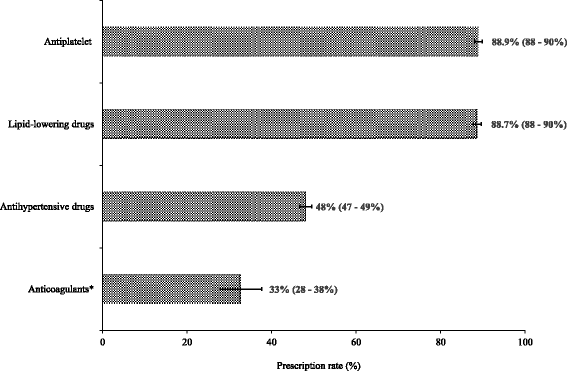Prescription of secondary preventive drugs after ischemic stroke: results from the Malaysian National Stroke Registry
- PMID: 29169331
- PMCID: PMC5701494
- DOI: 10.1186/s12883-017-0984-1
Prescription of secondary preventive drugs after ischemic stroke: results from the Malaysian National Stroke Registry
Abstract
Background: Evaluation of secondary stroke prevention in low and middle-income countries remains limited. This study assessed the prescription of secondary preventive drugs among ischemic stroke patients upon hospital discharge in Malaysia and identified factors related to the prescribing decisions.
Methods: From Malaysian National Stroke Registry, we included patients with non-fatal ischemic stroke. Prescriptions of antiplatelet, anticoagulants, antihypertensive drugs and lipid-lowering drugs were assessed. Multi-level logistic regressions were performed to determine the relation between potential factors and drug prescriptions.
Results: Of 5292 patients, 48% received antihypertensive drugs, 88.9% antiplatelet and 88.7% lipid-lowering drugs upon discharge. Thirty-three percent of patients with an indication for anticoagulants (n = 391) received it. Compared to patients <=50 years, patients above 70 years were less likely to receive antiplatelet (OR: 0.72, 95% CI: 0.50-1.03), lipid-lowering drugs (OR: 0.66, 95% CI: 0.45-0.95) and anticoagulants (OR: 0.27, 95% CI: 0.09-0.83). Patients with moderate to severe disability upon discharge had less odds of receiving secondary preventive drugs; an odds ratio of 0.57 (95% CI: 0.45-0.71) for antiplatelet, 0.86 (95% CI: 0.75-0.98) for antihypertensive drugs and 0.78 (95% CI: 0.63-0.97) for lipid-lowering drugs in comparison to those with minor disability. Having prior specific comorbidities and drug prescriptions significantly increased the odds of receiving these drugs. No differences were found between sexes and ethnicities.
Conclusions: Prescription of antihypertensive drugs and anticoagulants among ischemic stroke patients in Malaysia were suboptimal. Efforts to initiate regular clinical audits to evaluate the uptake and effectiveness of secondary preventive strategies are timely in low and middle-income settings.
Keywords: Anticoagulants; Antihypertensive agents; Brain ischemia; Hydroxymethylglutaryl-CoA reductase inhibitors; Platelet aggregation inhibitors; Secondary prevention.
Conflict of interest statement
Authors’ information
Not applicable.
Ethics approval and consent to participate
Ethical approval was obtained from Medical Research and Ethics Committee, Ministry of Health Malaysia (ID: NMRR 08–1631-3189). The approval includes data collection and use of data for secondary analysis. With a waiver of informed consent, a public notice is displayed at all participating sites and participants have the option to opt out.
Consent for publication
Not applicable.
Competing interests
The authors declare that they have no competing interests.
Publisher’s Note
Springer Nature remains neutral with regard to jurisdictional claims in published maps and institutional affiliations.
Figures



References
-
- Who | Cardiovascular Diseases (Cvds): World Health Organization; 2016 [cited 2016 4th October ]. Available from: http://www.who.int/mediacentre/factsheets/fs317/en/.
-
- Yusuf S, Islam S, Chow CK, Rangarajan S, Dagenais G, Diaz R, et al. Use of secondary prevention drugs for cardiovascular disease in the Community in High-Income, middle-income, and low-income countries (the pure study): a prospective epidemiological survey. Lancet. 2011;378:1231–1243. doi: 10.1016/S0140-6736(11)61215-4. - DOI - PubMed
MeSH terms
Substances
Grants and funding
LinkOut - more resources
Full Text Sources
Other Literature Sources
Medical

